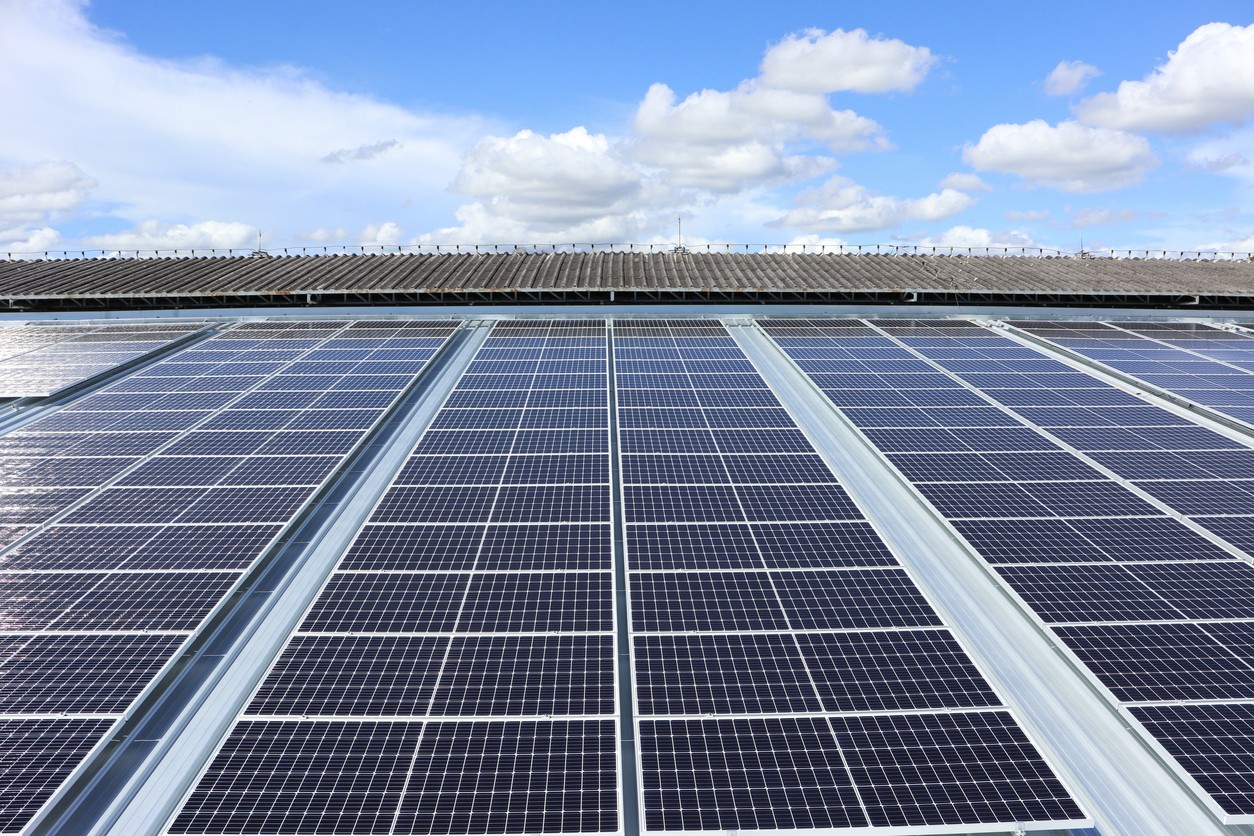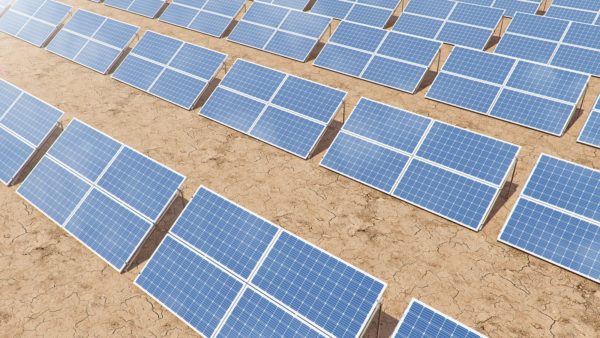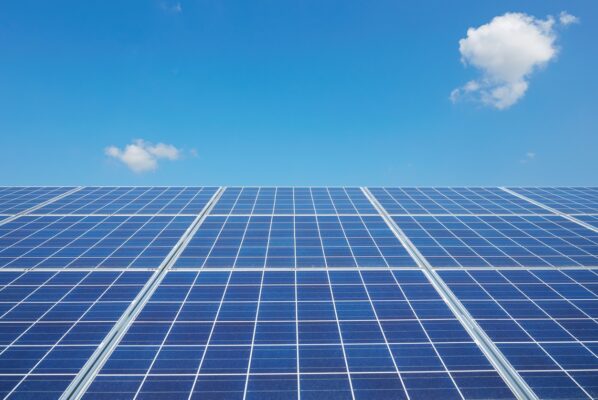
Solar energy is now widely used and powering more businesses than ever. If you are deciding on installing commercial solar panels, it makes sense to carefully consider every component of your solar energy system, especially whether to use monocrystalline or polycrystalline solar panels.
The type of solar panels you choose will affect their efficiency, working, cost, and durability. The solar panel on your solar system is to harness solar energy to generate electricity or heat. Solar thermal panels generate heat, while photovoltaic solar panels generate electricity.
Photovoltaic solar panels have always been more popular than thermal solar panels, despite being more expensive, since they do multiple tasks as opposed to thermal solar panels, which just heat the air or water.
Monocrystalline and polycrystalline solar panels are the two main subcategories of photovoltaic solar panels. We will discuss the difference between monocrystalline and polycrystalline solar panels below.
What is a Solar Panel?

Solar panels come in two types; thermal and photovoltaic solar panels. Solar thermal panels need sunlight to generate heat, while PV solar panels use photovoltaic technology to harness solar energy and turn it into electricity.
Photovoltaic solar panels are the best for smaller setups and are preferred by most homeowners. Despite being less effective than solar thermal panels, they are more practical for use because they don’t need extensive infrastructure.
The solar panel is like a picture in a frame. It has a rectangular shape, has a metal frame surrounding it, and has safety glass up front. A solar panel is made of various layers, but the most significant part contains an array of solar cells.
Each solar panel contains between 32 and 96 solar cells, which are all connected side by side to produce an electric output of 230 to 275 watts.
There are monocrystalline and polycrystalline solar panels available. The most expensive panel is made of monocrystalline solar cells since they are more efficient at capturing solar energy. Polycrystalline panels are less expensive and can be an excellent choice for locations with a lot of sunlight.
What is a Monocrystalline Solar Panel?

Monocrystalline solar cells are used to create monocrystalline solar panels, also known as mono panels. Each solar cell is a piece of silicon crystal that was produced specifically to be used in solar panels.
The crystal is developed into an ingot shape in the laboratory before being divided into thin discs. The edges of the discs are cut or sliced to create octagons.
The octagonal forms of the solar panels enable them to fit the maximum number of solar cells into the array when the solar cells are mounted on the panels. This can be illustrated by using octagonal cookies instead of round cookies: you can fit more cookies on the baking sheet if they are octagonal rather than round.
Monocrystalline solar panels are recognizable by their dark color and normally range in efficiency from 15% to 20%, while some more recent experimental types have even reached close to 50%.
Applications of Monocrystalline Solar Panel
- Monocrystalline solar panels are used in locations with less sunlight.
- They have smaller applications
- They are more efficient but pricey
Since they produce more electricity on a smaller scale than polycrystalline solar panels, monocrystalline solar panels are ideal for locations with limited space. Even in locations with less sunlight, monocrystalline solar panels can capture the highest amount of energy. They are perfect if you are looking for efficient solar panels and the cost is not your primary concern.
Although all solar panels are large, monocrystalline panels blend into the background more effectively than poly units due to their dark color.
Compared to polycrystalline panels, monocrystalline solar panels offer superior heat tolerance. Monocrystalline panels are a wise choice for you if you are residing in a hot climate like a desert.
Pros and Cons of Monocrystalline Solar Panel
Pros:
- Highly effective in generating energy
- Less space is needed for the panels because they blend seamlessly with darker regions or vegetation.
- Superior tolerance to heat
Cons:
- Non-sustainable production techniques
- Costly
What is a Polycrystalline Solar Panel?

Individual polycrystalline solar cells are used to create polycrystalline solar panels. They are also known as poly panels. Polycrystalline solar cells are created from silicon crystals, like monocrystalline solar cells. What makes them different from monocrystalline is that the silicon crystal cools and breaks apart on its own instead of releasing it as a single pure ingot. These pieces are broken up and then heated in an oven to melt and make cubes. They are then divided into thin wafers.
This amalgam is made of many different crystals, unlike the single crystal of mono panels. It allows for more solar cells to be produced faster and more affordable than monocrystalline cells because the manufacturing process is less demanding.
The blue square polycrystalline cells are perfectly stacked, one on top of the other with no gaps. Because there is less space for electron movement in polycrystalline solar panels than in monocrystalline ones, they perform less efficiently than monocrystalline solar panels.
Typically, polycrystalline solar panels have an efficiency rating of 13% to 16%. The percentage difference may seem low for a few solar panels, but the number can be multiplied for several solar panels.
Pros and Cons of Polycrystalline Solar Panel
Pros:
- Cheaper than monocrystalline solar panels
- Lifespan is the same as monocrystalline solar panels at a cheaper price
Cons:
- Panels take up more space and produce energy less sustainably
- Their blue color is more noticeable than monocrystalline panels
- Less tolerance to heat
Applications of Polycrystalline Solar Panel
- Polycrystalline solar panels are preferable for larger regions
- They are suitable for areas with more sunlight
- Appropriate when aesthetics are not a top priority
- They are affordable
If you live where there is more sunlight and want to buy solar panels on a minimum budget, you can opt for polycrystalline solar panels.
As long as you have enough space for mounting the panels, polycrystalline units are a better option because monocrystalline panels typically cost more. Due to their lower output, polycrystalline solar panels perform better in places with abundant sunlight.
Polycrystalline or Monocrystalline: Which Is Better?
The purpose of monocrystalline and polycrystalline panels in a solar system is the same, and the science behind them is straightforward; they convert solar energy into electricity.
Furthermore, they are both created with silicon, an incredibly abundant element on the earth’s crust, and used to make solar panels. Various companies make both types of solar panels.
Both monocrystalline and polycrystalline solar panels can be excellent options for your business, but before making your final solar purchasing decision, you should be aware of several important distinctions.
The type of silicon solar cell each of the two technologies uses sets them apart. Monocrystalline panels use silicon solar cells made of a mono-silicon crystal, while polycrystalline panels use silicon solar cells made from many silicon fragments that have been melted together.
It all comes down to the stats in the end. Here are a few major comparisons between monocrystalline and polycrystalline solar panels.
1. Cost
When comparing just the panels, monocrystalline solar panels are more expensive than polycrystalline solar panels. But that doesn’t necessarily imply they aren’t your ideal choice. The silicon structure is the key determinant of the difference in the price between these two types of solar panels.
Manufacturers pour molten silicon into square molds to create polycrystalline panels and separate the wafers into separate cells. On the other side, the solidification process of monocrystalline solar panels requires more control. The complicated procedure of mono panels drives up the cost of this type.
Monocrystalline solar panels are more expensive when comparing the costs of the two types of panels. However, both systems have the same price for wiring, inverters, racking, electrical safety measures, and labor.
Additionally, if you just have a little space for a commercial solar installation, remember that monocrystalline panels may provide you with a better return on your investment due to their higher efficiency. Keep in mind that the federal solar tax credit is still available for both varieties of solar panels.
2. Efficiency
Because monocrystalline solar panels are made from a single silicon crystal, which facilitates the largest amount of electricity moving throughout the panel, they are typically more efficient than polycrystalline solar panels.
In some cases, monocrystalline solar panels can achieve efficiencies of over 23%, although the maximum efficiency of typical polycrystalline types is about 20%.
3. Aesthetics
Monocrystalline solar panels are typically black, but polycrystalline panels may appear to have a blue tint to them. This is the fundamental aesthetic difference between the two types of solar panels.
4. Lifespan
The longevity of your solar panels is mostly unaffected by the sort of silicon cell that makes them up. For at least 25 years, both monocrystalline and polycrystalline solar panels will efficiently produce power.
5. Temperature Coefficient
Similar to efficiency, monocrystalline solar panels often perform better in terms of temperature coefficient than polycrystalline ones. Monocrystalline solar panels work better in high temperatures as the panel’s temperature coefficient measures how well it performs in warm temperatures closer to zero.
Turn to Coldwell Solar for Your Commercial Solar Solutions
We have discussed two types of solar panels, monocrystalline and polycrystalline. Polycrystalline solar panels are ideal if you have a limited budget but ample space for mounting solar panels. And, if cost is not your primary concern and you want efficiency, we recommend you get monocrystalline solar panels.
However, polycrystalline panels can still be beneficial depending on your circumstances and where you live. They are less effective than monocrystalline panels, as we have already covered, but if you have a lot of room, they are suitable for you.
Monocrystalline panels can also be a good investment. In general, monocrystalline solar panels are more efficient and perform better in higher temperatures.
If you need more information regarding which solar panels you should get for commercial use or to start your commercial solar project, contact Coldwell Solar for more information.

